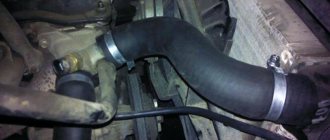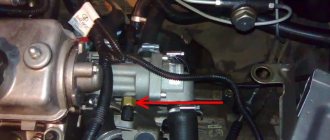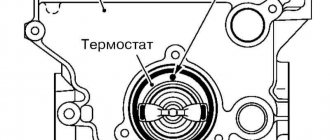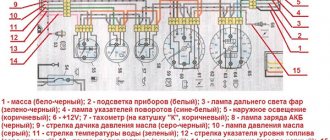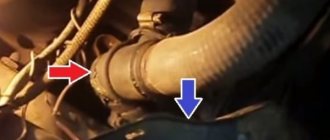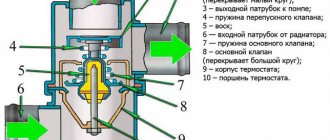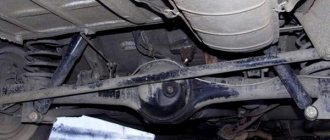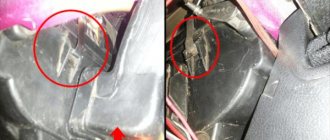Purpose of the thermostat on the VAZ 2106
The thermostat must control the degree of heating of the coolant and react in a timely manner when the antifreeze temperature becomes too high or, conversely, too low.
The thermostat maintains the temperature of the coolant in the engine cooling system in the desired range
The device can direct coolant through either a small or large cooling circle, thereby preventing the engine from overheating, or, conversely, helping it quickly warm up after a long period of inactivity. All this makes the thermostat the most important element of the VAZ 2106 cooling system.
Thermostat location
The thermostat in the VAZ 2106 is located to the right of the engine, where the pipes for discharging coolant from the main radiator are located. To see the thermostat, simply open the hood of the car. The convenient location of this part is a big plus when it becomes necessary to replace it.
To gain access to the VAZ 2106 thermostat, simply open the hood
Principle of operation
As mentioned above, the main task of the thermostat is to maintain the engine temperature within specified limits. When the engine needs to warm up, the thermostat blocks the main radiator until the engine reaches the optimal temperature. This simple measure can significantly extend the life of the engine and reduce wear on its components. The thermostat has a master valve. When the coolant reaches a temperature of 70 °C, the valve opens (it should be noted here that the opening temperature of the main valve can be higher - up to 90 °C, and this depends both on the design of the thermostat and on the thermal filler that is in it used).
Essentially, a thermostat is a regular valve that responds to changes in antifreeze temperature
The second important element of the thermostat is a special compression cylinder made of brass, inside of which there is a small piece of technical wax. When the antifreeze in the system reaches 80 °C, the wax in the cylinder melts. As it expands, it presses on the long rod connected to the main thermostat valve. The rod extends from the cylinder and opens the valve. And when the antifreeze cools, the wax in the cylinder begins to harden, and its expansion coefficient decreases. As a result, the pressure on the rod weakens and the thermostatic valve closes.
By opening the valve here we mean moving its leaf by only 0.1 mm. This is the initial opening value, which consistently increases by 0.1 mm as the antifreeze temperature rises by two to three degrees. When the coolant temperature rises by 20 °C, the thermostat valve opens fully. The full opening temperature can vary from 90 to 102 °C depending on the manufacturer and design of the thermostat.
- Thermostat for VAZ 2115 - device, replacement and repair
Lada 2106 Clover › Logbook › Adjustable thermostat
Hi all. I got confused with the cooling system. But more on that later. It came down to the thermostat. During the experiments, the old Soviet one stopped closing tightly. I already wanted to buy a new one, I walked around the market and was amazed. They sell crap and it’s expensive, and anything that’s a little better (Luzar, AvtoVAZ) looks like a fake. In general, I wanted the Metal Incar 83C in a metal version. It's not fate to find it. For that, there was already a new Fenox bought for 500 rubles, which opened at 65 degrees and cooled the coolant. That's where it came in handy. I couldn't afford to throw it away.
For modification, you can use a ready-made crane axle box or two bolts. I chose the second option because I need to drill a larger hole for the axle box, and I don’t have a step drill yet.
Next I drilled a hole in the thermostat. I cut the bolts to the required length with a grinder. I drilled a crooked hole in a large M5 bolt and cut an M6 thread. The bolt is screwed into one another onto a fum tape.
Next, drill a hole in the thermoelement support with an M4 drill
Since this thermostat opens early, it is necessary that when the thermoelement heats up, its rod climbs into the drilled hole in the support and rests against the bolt at 85 degrees. This moment is picked up on the fly. At the beginning I tightened the bolt “by eye”, I saw the temperature arrow hovered at 80 degrees while driving. I unscrewed the bolt a quarter turn and it went to 90.
Types of thermostats
The VAZ 2106 car was produced for many years. And during this time, engineers made a number of changes to it, including thermostats. Let's look at what thermostats were installed on the VAZ 2106 from the release of the first cars to the present day.
Single valve thermostat
Single-valve thermostats were installed on the very first “sixes” that rolled off the VAZ assembly line. The operating principle of this device has been described in detail above. To date, these devices are considered obsolete, and finding them on sale is not so easy.
The first “sixes” were equipped with the simplest, single-valve thermostats
Electronic thermostat
An electronic thermostat is the latest and most advanced modification that replaced single-valve devices. Its main advantages are high accuracy and reliability. Electronic thermostats have two operating modes: automatic and manual.
Electronic thermostats are used in modern cooling systems and differ from their predecessors in high accuracy and much greater reliability
Liquid thermostat
Thermostats are classified not only by design, but also by the type of fillers. Liquid thermostats were the very first to appear. The main component of a liquid thermostat is a small brass cylinder filled with distilled water and alcohol. The operating principle of this device is the same as that of the wax-filled thermostats discussed above.
Solid thermostat
The filler in such thermostats is ceresin. This is a substance similar in consistency to regular wax, which is mixed with copper powder and placed in a copper container. The cylinder has a rubber membrane connected to a rod, also made of dense rubber that is resistant to high temperatures. Ceresin, expanded from heating, presses on the membrane, which, in turn, acts on the rod and valve, ensuring the circulation of antifreeze.
The main element of a solid-fill thermostat is a container with ceresite and copper powder
Which thermostat is better
Today, thermostats based on solid fillers are considered the best option for the VAZ 2106, since they have the optimal combination of price and quality. In addition, they can be found in any auto store, unlike liquid single-valve ones, which are practically no longer on sale.
- Thermostat VAZ 2112 16 valves
Thermostat operating principle
The purpose and principle of operation of the VAZ 2106 thermostat is as follows: this thermodynamic component of the cooling system makes it possible to operate the “six” engine in the proper temperature regime using the functionality of thermostats or phase transition. There are such devices with a thermal insulating casing, which makes it possible to reduce temperature losses. Recently, devices with ceramic coating have appeared.
Let's look at how the thermostat works in a car's cooling system. It blocks the premature entry of antifreeze into the radiator cavity, at the initial stage creating the necessary conditions for the “engine” to enter the operating temperature regime. The functionality of the thermostat provides for its work to reduce wear of the power plant by maintaining the required temperature values in the system. It remains closed as long as the thermal range of the motor unit is maintained at the required level.
If the temperature conditions of the engine begin to exceed 90-95 degrees Celsius, the valve in the device releases the previously closed engine cooling jacket, allowing antifreeze to penetrate into the power plant and reduce its temperature to operating values.
A car thermostat for a VAZ 2106, the price of which is in the range of 550-600 rubles, can be purchased at many spare parts stores. Car enthusiasts often ask which thermostat is better, which manufacturer produces high-quality devices. Experts suggest using thermostats from Pramo or AvtoVAZ; the product from Luzar has proven itself well.
Signs of a broken thermostat
There are a number of signs that clearly indicate that the thermostat is faulty:
- The light on the instrument panel is constantly on, indicating that the engine is overheating. This usually happens because the thermostat valve has closed and is stuck in that position;
- The engine warms up very poorly. This means that the thermostat valve does not close tightly. As a result, antifreeze flows through both the small and large cooling circles and cannot warm up in a timely manner;
- After the engine starts, the lower thermostat tube heats up literally within a minute. You can check this by simply placing your hand on the nozzle. This situation indicates that the thermostat valve is stuck in the fully open position.
If any of these symptoms are detected, the driver should replace the thermostat as soon as possible. If the car owner ignores the above symptoms, this will inevitably lead to overheating of the engine and its jamming. It is extremely difficult to restore an engine after such a breakdown.
Methods for checking the thermostat
There are four main ways to test the thermostat's functionality. We list them in increasing order of complexity:
- The engine starts and idles for ten minutes. After this, you need to open the hood and carefully touch the lower hose coming out of the thermostat. If the device is working correctly, the temperature of the lower hose will not differ from the temperature of the upper one. After ten minutes of operation they will be warm. And if the temperature of one of the hoses is significantly higher, the thermostat is broken and needs to be replaced.
- The engine starts and idles. After starting the engine, you need to immediately open the hood and put your hand on the hose through which antifreeze enters the upper part of the radiator. If the thermostat is working properly, this hose will be cold until the engine is properly warmed up. If the thermostat is working properly, then immediately after starting the engine, the hose leading to the radiator will remain cold, and when the engine is fully warmed up, it will become hot
- Check in liquid. This method involves removing the thermostat from the car and submerging it in a pan of hot water and a thermometer. As mentioned above, the temperature at which the thermostat fully opens varies from 90 to 102 °C. Therefore, it is necessary to immerse the thermostat in water when the thermometer shows a temperature within these limits. If after diving the valve instantly opens, and after removal from the water it gradually closes, then the thermostat is working. If not, you need to change it. To check the operation of the thermostat, you only need a pan of water and a thermometer
- Check using the ICH-10 hour indicator. The previous testing method only allows you to establish the very fact of opening and closing the valve, but does not make it possible to accurately determine the temperature at which all this happens. In order to measure it, you need a clock indicator, which is installed on the thermostat rod. The thermostat itself is immersed in a container with cold water and a thermometer (the thermometer division should be 0.1 °C). Then the water in the pan begins to heat up. This can be done either using a boiler or by putting the entire structure on gas. As the water heats up, the degree of valve opening is monitored and recorded and displayed on a dial indicator. The observed numbers are then compared with the stated thermostat specifications, which can be found in the vehicle's owner's manual. If the difference in numbers does not exceed 5%, the thermostat is working; if not, it needs to be replaced. Checking with a dial indicator gives greater accuracy compared to the method that uses a conventional thermometer
Video: checking the thermostat
Changing the thermostat on a classic - explanation of the replacement steps
- We drain the antifreeze, we discussed how to do it correctly in the article on how to change the coolant in a VAZ. In our case, you can close the cabin heater tap so as not to drain the liquid from the stove.
- We remove the terminals from the battery and pull it out of the car.
This should be done to facilitate access to the thermostat when replacing it.
Additionally, removing the washer reservoir will help free up space for work on models with an injection engine. To do this, pull off the terminals of the motor wires, remembering their location, move the tank up the bracket and place it in the air intake box. The flexible tube going to the windshield nozzles is long enough, so you can do without disconnecting it and draining the washer fluid.
Advertising:
- Unscrew the clamps and remove them.
It is advisable to replace them with new ones. Because, over time, they stretch, and when the hose is pressed again, they can leak or unscrew on their own. Ideally, you should use spring clamps, used on modern cars, instead of tape or worm clamps.
When installing such connecting elements, it is extremely important to choose the correct diameter.
Advertising:
- We remove the thermostat and replace it with a new one.
It is best to first release the part from the shortest pipe leading to the cylinder block by pulling the assembly towards you. After this, removing the upper hose attached to the cylinder head and the side hose (to the radiator) will not be difficult.
At the same time, we carry out diagnostics of the hoses for elasticity and absence of ruptures and cracks. Otherwise, we change them. It is advisable to inspect the pipes before carrying out work, so that, if necessary, you can purchase a new spare part in advance.
- Before installing a new thermostat, it must be inspected.
We carry out a visual inspection. If there are burrs or casting defects on the nozzles, where the hose is attached, they should be treated with sandpaper or a file. We check that the insides of the thermostat are intact and that the valves are not stuck in the open position.
Video on how to check the functionality of a new thermostat before replacing it:
- We install the new thermostat in place.
We put the hoses on the pipes and tighten them with clamps.
Pour coolant into the system. We displace the air and check for leaks in the places where the thermostat is attached with hoses. If necessary, tighten the clamps. I described in detail how to properly fill in new antifreeze and not air out the system in previous articles; the link is provided at the beginning of the review.
We independently change the thermostat on a VAZ 2106
Before starting work, you should select tools and consumables. To replace the thermostat we will need:
- new thermostat;
- coolant (5 liters);
- basin for draining old antifreeze;
- flat screwdriver.
It should be noted here that the thermostat cannot be repaired. The reason is simple: inside it has a thermoelement with liquid or solid filler. It is the one that fails most often. But such elements are not sold separately, so the car owner has only one option - replacing the entire thermostat.
Sequence of work
Before performing any manipulations with the thermostat, you need to drain the coolant. Without this operation, further work is impossible. It is convenient to drain antifreeze by placing the car on an inspection hole and unscrewing the cap of the main radiator.
- After draining the antifreeze, the car hood opens. The thermostat is located to the right of the engine. Three hoses fit to it. All hoses from the thermostat must be removed
- The hoses are attached to the thermostat pipes using steel clamps, which are loosened using a flat-head screwdriver. It is most convenient to loosen the clamps on the thermostat hoses with a large flat-head screwdriver
- After loosening the clamps, the hoses are removed from the pipes manually, the old thermostat is removed and replaced with a new one. The hoses are returned to their place, the clamps are tightened, and new coolant is poured into the radiator. The thermostat replacement procedure can be considered complete. After removing the hoses, the VAZ 2106 thermostat is removed manually
Video: changing the thermostat yourself
So, the owner of a VAZ 2106 does not need to go to the nearest car service center to replace the thermostat. Everything can be done with your own hands. This task is entirely within the capabilities of a novice driver who has at least once held a screwdriver in his hands. The main thing is not to forget to drain the antifreeze before starting work.
Replacing the thermostat on a VAZ 2101-VAZ 2107
Welcome! A thermostat is a thing thanks to which the engine can warm up very quickly, or for a very long time, if the thermostat is removed from the cooling system (And this can be done by inserting instead an ordinary housing from a similar piece of hardware and connecting all three main pipes of the cooling system to it) then the liquid will immediately begin to run around in a large circle, in the summer this is good, because the car will not really warm up, especially in traffic jams, but as soon as winter comes, the problem that the car does not really warm up begins to manifest itself strongly, and excess fuel consumption appears in connection with this (You have to warm up the car longer), more heavy loads are placed on the engine, since engines are not designed to operate for a long time in a cooled state, because of this, only troubles occur and it seems like such a small thing, but it can create so many problems for your car and therefore, as soon as problems with cooling begin, we recommend immediately changing the thermostat and under no circumstances delay replacing it.
Note! To replace a thermostat in a classic, you will need a minimum set of tools, namely: A screwdriver (Although it also depends on how you attach the clamps to the connecting pipes; if they are bolted on, then you will need a wrench, so take this into account right away) and a container into which to drain you will have to coolant (Without draining the fluid, it is not possible to replace the thermostat, it will have to be partially drained and therefore not all of it will pour out of the cooling system, but still you will have to buy 5 liters from the auto shop of exactly the same fluid that is poured into the engine of your car!
Summary:
Where is the thermostat located? It is located below in the engine compartment of the car, in order to see it, you will have to lift the hood and find where the battery is located (By the way, you can remove it if it suddenly bothers you, and about how to remove the battery, read the article: “Replacing the battery with car"), as soon as the battery is removed, you will immediately see the thermostat; for clarity, in the photo below it is also indicated by a red arrow, and the blue one shows the place where the bar stands on which the battery is installed.
When should you change the thermostat? It’s very easy to check the thermostat, but you only need to check it when the engine starts to heat up incorrectly, the symptoms can be different, for some the car starts to heat up quickly and overheats and boils as a result, for others the car cannot really heat up (In the summer this is not too noticeable yet, but in winter it brings a lot of problems and inconveniences to all this), if you have any of these listed symptoms, then start checking the thermostat for functionality, to do this, start the car and let it warm up, while you feel the lower pipe which is connected to the radiator and to the thermostat (Indicated by a red arrow), it must begin to heat up only when the engine temperature reaches approximately 80-88 ° C, but if you notice that it does not heat up at all, and the engine is already overheating, then the thermostat is not is working properly, and also, if you notice that at a low temperature of 40-50 ° C, the lower pipe, along with the others, also began to heat up, then this means that the thermostat valve is constantly open and the liquid runs in a large circle, which is why the engine It heats up poorly and gasoline consumption increases significantly; in this case, the thermostat must also be replaced with a new one.
Note! The lower pipe is connected to the radiator, so you can also touch the radiator with your hand in the place where the lower pipe is connected to it, it should also begin to heat up only when the engine reaches a temperature of 80-88 ° C, more details on how to check the old thermostat which installed on the car and new before purchasing in a car store, watch the video below:
How to replace the thermostat on a VAZ 2101-VAZ 2107?
Note! Before replacing it, do not forget to drain the coolant from the car, but only do this on a cold engine, otherwise you will get burned (For information on how to drain the fluid, read the article: “Replacing coolant on a classic”), by the way, it is much easier to remove the thermostat from underneath the car, if you don’t have an inspection hole nearby, then you’ll have to crawl under the car by lifting one of its sides with a jack!
Removal: 1. The thermostat can be removed very easily, first disconnect all three pipes that are connected to it using a screwdriver or wrench (This all depends on which clamps are used to secure the pipes), for clarity, we have indicated in the photo below All the screws of the coupling clamps that secure the pipes, these screws will need to be loosened and then disconnect the pipes from the thermostat and then remove the thermostat from the car.
Note! We would like to warn you right away that on VAZ 2107 cars of the last years of production, the pipes are attached to the thermostat using tape clamps, which are very difficult to remove and require a special tool (This clamp can be seen in the right photo), if you notice just these clamps on your car, then don’t touch them, but just find the places where the pipes are attached, but not to the thermostat, but to other elements (the lower one is attached to the radiator, for example) and see how they are secured there (The pipes at the other ends should be secured with worm clamps, one of these clamps , shown in the photo on the left), if this is the case, then loosen the screws securing the pipes at the other ends and then remove the thermostat along with the pipes from the car, after removal you will figure out how to remove the band clamps (you can cut it off carefully with metal cutters)!
Installation: Installation of the thermostat is carried out in the reverse order of removal; if you had band clamps, then replace them with worm clamps and we also recommend lubricating the inside of the pipes in the places where they are connected to the thermostat with silicone sealant to eliminate the leakage of coolant through them.
Note! When installing a new thermostat, we recommend checking it, to do this, put it in hot water (Use a thermometer, determine when the water warms up to approximately 75-78 ° C) and stirring it, heat the water to a temperature of 87 ± 2 (This is for a thermostat with a temperature of 87 ° C ) or up to 80.6-81.5 (This is for a thermostat with a temperature of 80 ° C), this temperature is written on them themselves. By the way, when you buy a new thermostat, you will most likely be asked the question at what degrees do you need the thermostat to open, prepare for this question and go to the auto shop with the answer to it, let's go back to checking, when the thermostat warms up, its valve should open, you will immediately notice this and be sure to read the thermostat markings, we repeat once again, the valve opening temperature is written on them, if at this temperature, it opens (also take into account the error of 2 °C), which means the thermostat is working and can be installed on the car and the engine will no longer overheat (Exception: very large summer traffic jams)!
Thermostat VAZ 2106
An element of a vehicle’s liquid cooling system, such as a thermostat, is a device with which the vast majority of passenger cars are equipped. It is located in the engine compartment in the space around the engine in the pipeline network between the power plant and the radiator. Externally, it is a sealed cylinder made of light alloy materials with holes, to which the cooling system pipes are connected.
Table of contents
Replacement How to check How to change Faults
- Grant's thermostat
Replacement
To replace the thermostat on VAZ 2106 cars, you need to drain some of the coolant by unscrewing the drain plug on the cylinder block. It is also necessary to remove the battery, which will interfere with our ability to carry out repairs to replace the thermostat. Next, loosen the clamps securing the hoses to the thermostat and disconnect the hoses, then remove the thermostat.
After removing the thermostat, it must be checked for functionality; to do this, lower it into a container with water heated to 78-80 degrees and, with constant stirring, continue to heat the water to 87-90 degrees. The thermostat valve should slowly begin to open; if this does not happen, the thermostat must be replaced. Install the new one in reverse order. Fill with coolant.
What to do if there is an air lock in the cooling system.
How to change the ignition switch follow the link.
Adjusting electronic ignition https://vz06-up.ru/sz/elektronnoe-zazhiganie-na-vaz-2106.html#t4.
How to check
Checking without removing the thermostat
EXECUTION ORDER
Before removing and checking the functionality of the thermostat, make sure that engine cooling problems are not due to insufficient coolant or low drive belt tension. Make sure the indicator located on the instrument cluster is working properly.
If you notice that the engine takes a long time to warm up to operating temperature (according to the indicator), the thermostat may be stuck open. In this case, the thermostat should be replaced.
On the other hand, long warm-up times may be due to the lack of a thermostat. This could have been done on purpose or unintentionally (they forgot to install it after repair). Do not use a car without a thermostat. The engine management system will keep the engine in warm-up mode for a longer period of time. During this time, the engine will consume more fuel, and the exhaust gases will contain more harmful impurities.
If the engine is overheating, touch the upper radiator hose. If it is not hot and the engine is overheated, the thermostat may be stuck closed. The liquid does not enter the radiator and circulates in a small circle. In this case, replace the thermostat.
If the upper radiator hose is hot, this means that the thermostat is open and fluid is circulating normally through the system. In this case, read the recommendations given in the Fault Diagnostics Section.
Checking by removing the thermostat
EXECUTION ORDER
Remove the thermostat (see Section Removing and installing the thermostat).
If the thermostat is open at room temperature, it is faulty and must be replaced.
To make a rough test of the thermostat's functionality, hang it on a piece of twine in a container of water. The thermostat should not touch the walls of the container. Start heating the container.
As the water heats up, the thermostat should open (this happens just before the water boils). Since the boiling point of water is 100°C, the thermostat may not open completely (refer to Specifications). Remove the thermostat and let it cool. As it cools, it should close completely.
If the thermostat does not open when heating or does not close when cooling, replace it.
When installing the thermostat, pay attention to the following points:
a) Thoroughly clean the mating surfaces and replace the O-ring;
b) Place the thermostat in the housing, oriented correctly;
c) Tighten the cover mounting bolts using the required force;
d) Install all hoses in their original places, then fill in coolant (refer to the Chapter Routine care and maintenance);
e) Start the engine, warm it up to operating temperature and check for leaks.
How to change
Before installing a new device, you need to check it - put it in hot water (about 80 degrees), after which the water needs to be heated and stirred constantly, thereby bringing it to about 87 degrees. If the main valve opens, then the thermostat is working.
Malfunctions
Thermostat does not open
Reason: it is jammed or the valve plate is stuck.
Signs: the temperature display is already beyond the red mark, and the radiator is still cold to the touch.
Possible consequences: Driving with the thermostat closed can cause severe engine damage. The cylinder head gasket may burn out, the cylinder head may become deformed, or cracks may appear on it.
Remedy: Wait until the engine has cooled, unscrew the thermostat housing and remove the thermostat. Driving without a thermostat for a while will not harm your engine.
Thermostat does not close completely
Cause: A foreign object has entered the thermostat.
Symptoms: After starting a cold engine, the radiator immediately becomes as warm as, for example, the thermostat housing. The car interior heats up slowly.
Possible consequences: If the engine does not reach operating temperature, wear on its parts increases.
Remedy: Replace the thermostat.
The VAZ 2106 thermostat is a device whose main task is to control the normal temperature regime of the internal combustion engine. Used with a liquid cooling system. When the engine is cold, the engine cooling liquid does not circulate through the heat removal lines. When the engine reaches 95 °C, the thermostat allows coolant to circulate. Thanks to this temperature regulator, the car's power plant warms up much faster, which allows you to extend the service life of parts of the crank and gas distribution mechanisms, as well as elements of the cylinder-piston group.
Return to contents
Thermostat VAZ-2107 - methods of checking and correct replacement
The vehicle's thermostat is used to maintain the engine operating temperature within specified limits. A faulty device must be replaced, since operating the machine with it can lead to overheating of the engine or a decrease in its service life.
Purpose and design of the VAZ-2107 thermostat
In the engine cooling system, the thermostat is installed at the intersection of the pipes from the engine and radiator to the pump. After starting the engine when cold, the thermostat is closed - it blocks the passage from the radiator when it is completely open from the engine. The coolant circulates in a small circle through the cylinder block and pump, which ensures quick warm-up of the engine. When the antifreeze temperature reaches values close to the operating temperature (for a VAZ-2107 with a carburetor 80.6–81.5 o C), the main thermostat valve begins to open, freeing the passage of the pipe from the radiator, and at the same time the bypass valve begins to block the flow of antifreeze from the engine. The pump also begins to “drive” the antifreeze in a large circle: cylinder block, radiator, thermostat, pump. When the antifreeze temperature reaches operating values (for VAZ-2107 94 o C), the thermostat opens completely:
- the pipe from the engine is completely blocked;
- from the radiator is completely open.
Antifreeze circulates only in a large circle. When cooling the antifreeze, the reverse process occurs.
The VAZ-2107 temperature regulator, regardless of the engine type (with injector or carburetor), has the following design:
- non-separable cylindrical body with three pipes;
- directly the thermostat itself.
Malfunctions and testing of the VAZ-2107 thermostat
- does not open at all or opens partially - leads to engine overheating;
- does not close - the engine heats up slowly after a cold start, the engine does not reach operating temperature.
To find out the functionality of the thermostat, you should check at what temperature its main valve begins to open, as well as the stroke of this unit. Since the thermostat itself is mounted in a non-separable housing, this can only be done accurately using special equipment (for example, the BS-106.000 stand).
The simplest check of the VAZ-2107 thermostat can be performed directly on the car by touch.
In the case of a working thermostat, after starting a cold engine, the lower radiator tank should not heat up immediately, but when the arrow on the coolant temperature gauge is 3–4 mm from the red scale zone, which corresponds to 80–85 °C.
If the radiator starts to heat up immediately, this means that the thermostat is not closing. If it’s later, its valve gets stuck. An overheating engine can be evidence of insufficient valve travel when it does not open completely. In all cases, the thermostat must be replaced.
Replacing the thermostat VAZ-2107
First, the antifreeze is drained from the cooled engine. Using a slotted screwdriver with a thin blade or pliers, loosen the clamp securing the hose supplying antifreeze from the radiator to the thermostat pipe. Disconnect this hose.
Use a Phillips screwdriver or an 8 mm socket wrench to loosen the clamps securing the hoses to the pipes of the cylinder block and pump. Remove the thermostat along with the hoses.
Disconnect the hoses from the thermostat pipes and put them on the new thermostat. Instead of the tape clamps that were on the hoses, they put on worm-drive clamps without tightening them.
The lower pipe of the thermostat is connected to the hose from the radiator. Connect the remaining hoses. All clamps are tightened. Fill in coolant. Start the engine and check for antifreeze leaks and the operation of the new thermostat.
Design and functional properties
The materials for the manufacture of parts of the body and filling of the thermostat of the VAZ 2106 car are brass and copper. The working process of the thermostat is as follows:
- A spherical piece of wax is placed in the cylinder of the device, which begins to melt when the engine reaches a temperature mark of 82 ° C.
- Having a significant coefficient of expansion, the wax begins to press on the end of the rod connected to the inlet valve.
- When the valve opens, coolant begins to circulate through the heat removal lines of the engine, cooling it.
- As the temperature drops, the wax begins to harden and shrink, which leads to a decrease in pressure on the rod, which returns to its place under the action of the return spring.
Problems with the thermostat arise when the engine is operated in incorrect operating modes: frequent overheating, prolonged driving with engine hyperthermia, or mechanical deformation of the thermostatic device.
If the valve jams in the closed position, severe overheating of the power plant occurs even at negative ambient temperatures. When the valve is partially opened, overheating still occurs, but under gentle operating conditions this will not lead to the engine boiling.
When the shut-off valve of the car thermostat is in the fully open position, the engine cannot warm up to the temperature required for normal operation. In this case, the wear of parts of the crank and gas distribution mechanisms increases, the required degree of expansion of the cylinder-piston group is not achieved, which leads to insufficient sealing of the combustion chamber and a decrease in the degree of compression.
Return to contents
Malfunctions and how they manifest themselves
There are three types of breakdowns:
- The small circle valve is constantly open, regardless of the coolant temperature. This happens when it becomes jammed or a foreign object gets into it: scale, dirt, etc. In this position, the engine will always overheat, its temperature will rise until the antifreeze in the system boils. Because it does not circulate in a large circle, does not pass through honeycomb radiators, and is not cooled.
How does this manifest itself? In motion, air passing through the radiator cools its cells, through which the liquid passes, it gives off heat. She's cooling down. If the thermostat is stuck in the closed position, then there will be no circulation in a large circle, the radiator will not participate in the engine cooling system, which means the temperature will constantly rise. This is indicated by the engine temperature indicator. If nothing is done, the liquid will boil in the system and you may end up with expensive engine repairs.
- The large circuit valve is always open. This is the opposite situation. The fluid will constantly circulate through the radiator. The engine will not be able to warm up to the required temperatures. This will lead to increased wear of its parts and excessive fuel consumption.
How does it manifest? The engine idles, but its temperature does not rise. It will fall as it moves. This is especially noticeable in the cold season.
- Valves are stuck in the middle position. The liquid circulates through two circuits. If the car is stationary and the engine is idling, then such a malfunction will be difficult to notice. The engine warms up, but not at the same speed as usual. As the vehicle moves, the coolant temperature will drop quickly.
Diagnosis of problems
To diagnose a thermostat malfunction, several steps must be taken.
- Warm up the car engine to 95-100 °C (when the thermometer needle slightly does not reach the red mark).
- Turn off the engine. Open the hood lid and find two radiator hoses.
- It is necessary to check their temperature, either by touch (extremely carefully) or with any instrument. If one of the hoses is cold, this indicates a malfunction of the thermostatic device and the need for its urgent replacement.
There is another way to check if the thermostat is working properly, but it involves completely removing the device from the car. The vehicle's thermostat is located in a container, which is filled with water heated to boiling water (100 °C).
After a short period of time, the shut-off valve should move to the open position. With this option, it is revealed that problems in the heat removal system are located in another node. If this does not happen, then the condition of the thermostat is determined to be unsatisfactory and requires replacement.
The operating temperature of the thermostat varies over a fairly wide range. Therefore, in order for the replacement to bring the expected results, you need to clarify the structural, technical and temperature characteristics of your vehicle before directly purchasing a temperature controller. Otherwise, the correct operation of both the engine and the thermostat itself will be called into question.
Return to contents
How to replace a thermostat?
In order to replace the thermostat on a VAZ 2106, you only need to prepare an ordinary screwdriver. Before starting dismantling work, you must remove the battery to avoid possible short circuit or electric shock.
Next you need to drain some of the coolant. To do this, remove the plug, which is located in the area of the cylinder block. After completing all these procedures, the thermostat should be directly replaced. Using a screwdriver, loosen the clamps (three pieces) that secure the pipes to the temperature control device. Now the thermostat itself is removed.
Before installation, the new device must be tested for serviceability and compliance with the correct temperature conditions for its operation. The test takes place in a container of water.
Unlike diagnosing an old thermostat (the test takes place in a liquid with a temperature of 95-100 °C), the new device is tested at a temperature not exceeding 87 °C.
Return to contents
Replacing the thermostat
This action can be performed in the event of a device failure. The thermostat is replaced if there is any doubt about its performance. This occurs when violations of the temperature range of the power plant are detected or when it is determined that it has not fully warmed up. It is not necessary to completely free the cooling system from antifreeze.
A routine check of the thermostat is carried out as follows: when starting the engine, it is necessary to check the temperature regime of the lower tubular outlet of the radiator, which ideally should be cold to the touch. After the antifreeze reaches a temperature of 87-92 °C, the lower outlet pipe should become warm. Otherwise, the device must be removed and checked for functionality.
Maintenance and repair work on this device should begin with the engine cooled down and the battery removed for convenience. In a VAZ 2106, replacing the thermostat is carried out with a set of driver's tools in the following order:
- We drain a certain amount of antifreeze by unscrewing the drain plug in the engine block.
- We dismantle the battery.
- We loosen the clamps of the clamps on the pipes leading to the thermostat, remove the pipes and the thermostat itself.
- We check the thermostat by lowering it into hot (78-80 °C) water. We bring the liquid temperature to 87±2 °C, at which the main valve of the device should open. If this is not the case, it is necessary to replace the thermostat in the cooling system.
- We install the new product in reverse order. To prevent cases of antifreeze leakage from the system connections, it is necessary to lubricate them with a sealed lubricant before tightening the pipes.
- Fill the radiator with antifreeze and squeeze out any air pockets from the system.
- This completes the work on replacing the thermostat.
In winter, when the stove is turned on, the temperature value becomes lower. This is a natural process and the standard thermostat cannot affect the thermoregulation of the cooling and heating system in any way. The car receives full heating of the interior only during long trips, and during short driving intervals followed by turning off the engine it does not really warm up.
To achieve room temperature conditions in the cabin, modification of the thermostat is required, the results of which will achieve the final goal - timely heating of the cabin. Achieving this result is only possible by directing the antifreeze back to the thermostat, since this product regulates the cooling process.
For this purpose, it is necessary to resolder the body of the device and direct the pipe from the pump to the thermostat, and install a reliable chopper into the hole in the pump, which will eliminate the possibility of coolant leakage. After modifying the thermostat, the temperature regime changes and the interior heats up much faster.
The VAZ 2106 thermostat is a device whose main task is to control the normal temperature regime of the internal combustion engine. Used with a liquid cooling system. When the engine is cold, the engine cooling liquid does not circulate through the heat removal lines. When the engine reaches 95 °C, the thermostat allows coolant to circulate. Thanks to this temperature regulator, the car's power plant warms up much faster, which allows you to extend the service life of parts of the crank and gas distribution mechanisms, as well as elements of the cylinder-piston group.
Types of thermostats
The VAZ 2106 car was produced for several decades, and during this time many components and assemblies have undergone changes. The same thing happened with the thermostat. Over the years of production, several types of these units were installed on the “six”.
Return to contents
Single valve thermostat
Simplest in design. It was installed on the first production models of the VAZ 2106. It is almost impossible to find it on sale, and besides, it makes no sense, since these devices had many shortcomings.
Return to contents
Electronic thermostat
On the contrary, it was installed on later models and was in many ways superior to the previous version with one valve. This device with an electronic valve is accurate and reliable and can operate in automatic and manual mode. Such units are used in many modern cooling systems.
Return to contents
Liquid
Depending on the type of valve filler, the device can be solid or liquid filled. The latter are considered obsolete. It is based on a brass cylinder containing alcohol or distilled water.
Return to contents
With solid filler
Ceresite is used as filling. In its consistency, it resembles regular wax mixed with copper powder. This substance is placed in a copper container. The container is equipped with a high-temperature resistant membrane and a heat-resistant rubber rod connected to it. As the ceresite heats up, it begins to expand and push the membrane, which transmits pressure to the rod, and the valve opens, allowing coolant to flow through a large circulation circle.
The best option today are thermostats with solid filler. They are reliable, durable and have an optimal combination of price and quality. In addition, this is the most common option in auto parts stores.
The efficiency of the stove and other parameters that affect the operation of the entire engine depend on the engine temperature. The temperature depends on the thermostat. A thermostat is a device that directs coolant through a large or small cooling circle.
The principle of operation and repair of the VAZ 2106 thermostat
The VAZ 2106 thermostat is a device whose main task is to control the normal temperature regime of the internal combustion engine. Used with a liquid cooling system. When the engine is cold, the engine cooling liquid does not circulate through the heat removal lines. When the engine reaches 95 °C, the thermostat allows coolant to circulate. Thanks to this temperature regulator, the car's power plant warms up much faster, which allows you to extend the service life of parts of the crank and gas distribution mechanisms, as well as elements of the cylinder-piston group.
Design and functional properties
The materials for the manufacture of parts of the body and filling of the thermostat of the VAZ 2106 car are brass and copper. The working process of the thermostat is as follows:
- A spherical piece of wax is placed in the cylinder of the device, which begins to melt when the engine reaches a temperature mark of 82 ° C.
- Having a significant coefficient of expansion, the wax begins to press on the end of the rod connected to the inlet valve.
- When the valve opens, coolant begins to circulate through the heat removal lines of the engine, cooling it.
- As the temperature drops, the wax begins to harden and shrink, which leads to a decrease in pressure on the rod, which returns to its place under the action of the return spring.
Problems with the thermostat arise when the engine is operated in incorrect operating modes: frequent overheating, prolonged driving with engine hyperthermia, or mechanical deformation of the thermostatic device.
If the valve jams in the closed position, severe overheating of the power plant occurs even at negative ambient temperatures. When the valve is partially opened, overheating still occurs, but under gentle operating conditions this will not lead to the engine boiling.
When the shut-off valve of the car thermostat is in the fully open position, the engine cannot warm up to the temperature required for normal operation. In this case, the wear of parts of the crank and gas distribution mechanisms increases, the required degree of expansion of the cylinder-piston group is not achieved, which leads to insufficient sealing of the combustion chamber and a decrease in the degree of compression.
Diagnosis of problems
To diagnose a thermostat malfunction, several steps must be taken.
- Warm up the car engine to 95-100 °C (when the thermometer needle slightly does not reach the red mark).
- Turn off the engine. Open the hood lid and find two radiator hoses.
- It is necessary to check their temperature, either by touch (extremely carefully) or with any instrument. If one of the hoses is cold, this indicates a malfunction of the thermostatic device and the need for its urgent replacement.
There is another way to check if the thermostat is working properly, but it involves completely removing the device from the car. The vehicle's thermostat is located in a container, which is filled with water heated to boiling water (100 °C).
After a short period of time, the shut-off valve should move to the open position. With this option, it is revealed that problems in the heat removal system are located in another node. If this does not happen, then the condition of the thermostat is determined to be unsatisfactory and requires replacement.
The operating temperature of the thermostat varies over a fairly wide range. Therefore, in order for the replacement to bring the expected results, you need to clarify the structural, technical and temperature characteristics of your vehicle before directly purchasing a temperature controller. Otherwise, the correct operation of both the engine and the thermostat itself will be called into question.
How to replace a thermostat?
In order to replace the thermostat on a VAZ 2106, you only need to prepare an ordinary screwdriver. Before starting dismantling work, you must remove the battery to avoid possible short circuit or electric shock.
Next you need to drain some of the coolant. To do this, remove the plug, which is located in the area of the cylinder block. After completing all these procedures, the thermostat should be directly replaced. Using a screwdriver, loosen the clamps (three pieces) that secure the pipes to the temperature control device. Now the thermostat itself is removed.
Before installation, the new device must be tested for serviceability and compliance with the correct temperature conditions for its operation. The test takes place in a container of water.
Unlike diagnosing an old thermostat (the test takes place in a liquid with a temperature of 95-100 °C), the new device is tested at a temperature not exceeding 87 °C.
Types of thermostats
The VAZ 2106 car was produced for several decades, and during this time many components and assemblies have undergone changes. The same thing happened with the thermostat. Over the years of production, several types of these units were installed on the “six”.
Single valve thermostat
Simplest in design. It was installed on the first production models of the VAZ 2106. It is almost impossible to find it on sale, and besides, it makes no sense, since these devices had many shortcomings.
Electronic thermostat
On the contrary, it was installed on later models and was in many ways superior to the previous version with one valve. This device with an electronic valve is accurate and reliable and can operate in automatic and manual mode. Such units are used in many modern cooling systems.
Liquid
Depending on the type of valve filler, the device can be solid or liquid filled. The latter are considered obsolete. It is based on a brass cylinder containing alcohol or distilled water.
With solid filler
Ceresite is used as filling. In its consistency, it resembles regular wax mixed with copper powder. This substance is placed in a copper container. The container is equipped with a high-temperature resistant membrane and a heat-resistant rubber rod connected to it. As the ceresite heats up, it begins to expand and push the membrane, which transmits pressure to the rod, and the valve opens, allowing coolant to flow through a large circulation circle.
The best option today are thermostats with solid filler. They are reliable, durable and have an optimal combination of price and quality. In addition, this is the most common option in auto parts stores.
Thermostat
A thermostat is a device that regulates temperature. Essentially, it is a shut-off and control device that opens, closes and changes the direction of flow of coolant. There are two cooling circuits in a car engine cooling system: large and small. The large circle is the circulation of fluid through the main radiator, and the small circle is the circulation of fluid bypassing the radiator.
The operation of the thermostat is regulated by a valve, which, depending on the temperature, opens one pipe and closes the second.
Springs
The design includes two springs. They help the valves “return” to their original position after the coolant has cooled, reliably isolating the two circulation circuits of the system from each other.
The thermostat itself is placed in a cylindrical housing with three pipes. Two are connected to different circulation circuits, the third to a water pump (pump).
Video showing how a thermostat works and is made:
Types of thermostats
Externally, if you take the thermostats of the Niva and VAZ 2101 (kopecks), the differences will not be visible. They have differences inside, the pipes are located differently.
Types of VAZ thermostats:
- Thermostat 2101-2107. The valve began to lock when it reached 80 degrees, and fully opened when it reached 95 degrees.
- Almost the same ones are installed on the VAZ Niva, only the angle between the pipes is about 180 degrees.
- The VAZ 2108 thermostat is installed on all VAZ models with carburetor engines of various modifications. The thermostat valves of front-wheel drive VAZs operate 7 degrees later than those of classic models.
- The thermostat of the VAZ 2110 is the same as the classic one, but the pipes are located in a mirror image. There is no small pipe for air outlet.
- The VAZ 2112 thermostat is made for VAZ injection engines. The valve opens when the temperature reaches 85 degrees.
Luzar thermostats
There are some negative and some positive reviews about Luzar thermostats. They write that after 5000 km it may leak. Manufacture: China.
Didn't find the information you are looking for? on our forum.
If you find an error, please select a piece of text and press Ctrl+Enter.
We recommend reading:
How to check current leakage on a VAZ 2110 car with a multimeterVAZ 21213 accelerates poorly Lada Largus which gasoline 92 or 95 to fill, manufacturer's recommendations How to change the starter on a VAZ 2109 VAZ 2107 stalls at idle, carburetor, injector, identify and solve the problem Timing belt slips VAZ 2109, 8 valves, reason and how to fix: When you press the brake pedal you can hear a hissing VAZ 2114VAZ 2121 how to change silent blocks on a car
